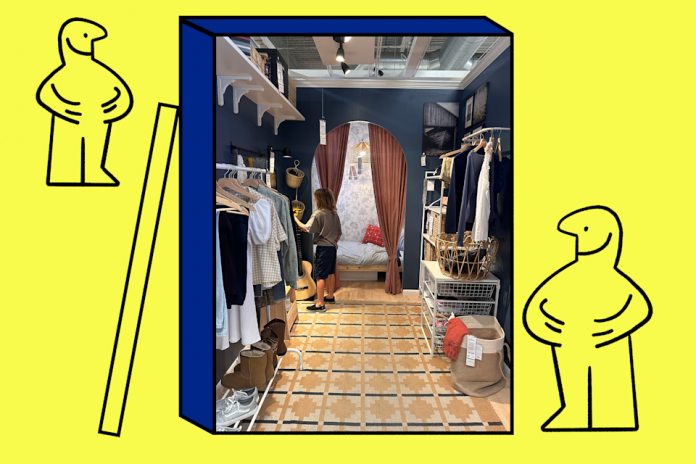Last week I flew to Connecticut to visit my family. I was excited about New England oysters, seeing my niece’s dance recital, taking my son to visit my old summer camp and one oddball mission: a trip to IKEA. Where I live in Nashville, Tenn., the closest IKEA is a three-hour drive away, in Memphis. So I was psyched to traipse through the New Haven location with my 9-year-old and stock up on everything from art supplies to striped pillowcases — and, of course, brilliant home reorganization ideas thanks to the IKEA showroom.
Two hours and 2,100 steps later, I walked out feeling … refreshed. Sure, I’d dropped cash on unnecessary (yet affordable!) stuffed animals and random kitchen sponges. But I’d also had a lovely walk-and-talk with my son, ate a surprisingly balanced lunch of veggie balls and green beans, and wandered through rooms intentionally designed to spark joy, creativity and even calm. If this experience — the IKEA effect, if you will — has also happened to you, maybe you too have found yourself wondering: Is a random trip to IKEA actually good for my health?
The research around IKEA shopping habits shows that customers really, truly love it there. In a study published by the Asia Pacific Journal of Management and Education, more than 80% of consumers surveyed answered the question, “How comfortable are you when shopping at IKEA instead of at any other stores?” with “satisfied” or “very satisfied.” And that feeling of satisfaction carries on once you’ve made your purchase and head home: Research published in the Journal of Consumer Psychology revealed that putting together IKEA products can actually increase your sense of self-worth.
Advertisement
Advertisement
From nutrient-dense food options to the mental boost of assembling a cabinet to the subtle Scandinavian principles of community, wellness and design, there are plenty of pros to an IKEA afternoon. Ahead, experts weigh in on how to harness the benefits.
Home away from home: Shoppers can engage with displays, giving the sprawling stores a more intimate vibe. (Photo Illustration: Liliana Penagos for Yahoo News, photo: Amelia Edelman)
The 2,000-step shopping experience
Not every shopping experience comes with a walk, but the IKEA layout — which requires that you meander your way through the showroom from beginning to end — does motivate you to get some steps in. I tracked my stroll and hit 2,100 steps by the time I was back in the parking lot. Still, I didn’t spend a ton of walking time total, since we were pausing constantly to shop, eat lunch, test out mattresses and the like.
That walk is a built-in and purposeful part of the IKEA setup. The brand’s signature blue stores are 215,000 to 500,000+ square feet in size, according to IKEA’s United States representative. That’s a lot of footage to hoof your way through — and it’s worth the walk.
Licensed social worker and psychotherapist Vikas Keshri says the IKEA layout is actually stress-busting in two different ways. First, just strolling through the store loop is enough mild physical activity to “release endorphins and reduce stress,” Keshri tells Yahoo Life. Second, the fact that your walk through the store is pre-set is also relaxing for your brain: Instead of having customers “scramble around the warehouse,” Keshri explains, “the route functions as a subconscious motion” rather than relying on the brain to make a plan.
Advertisement
Advertisement
He compares it to shopping at Costco. “[If] you need milk, you go to one end of the warehouse, and for bread, you go to the opposite end,” Keshri points out. “In an IKEA, since the path is pre-planned, your brain can stop actively mapping your trip, which reduces stress.”
I experienced this myself during my recent IKEA trip. As a (usually far too busy) working mom, I can suffer from decision overload. The simple act of not having to decide which way to go next — forward is the only option on the single-loop path — was certainly soothing.
IKEA food: Actually healthy, or a happy Scandi mirage?
I was most skeptical of this section of the store — of its health claims, at least. While IKEA’s café boasts plenty of signs touting the benefits of plant-based, sustainably sourced snacks, the IKEA I grew up with was known for its heavy-duty meatballs, Swedish apple cake and pancakes with lingonberry jam. Which IKEA food image is the true IKEA food image?
Well, the truth is it’s something of both. “IKEA’s food court now offers better nutritional options beyond just meatballs and mystery gravy,” explains nutritionist Scott Baptie. “The salmon fillet with bean mix and lemon dill sauce is a standout: This dish offers a combination of protein-rich nutrients and heart-friendly fats, which includes additional dietary fiber.” As for the vegetarian options on offer, “the plant balls alongside quinoa salads and the Swedish Caesar salad with egg and salmon provide balanced nutrition,” adds Baptie. I went for those plant-based balls myself, and my son opted for the plant-based nuggets kids’ meal.
Advertisement
Advertisement
IKEA’s plant-based menu options are more recent additions, but the brand’s integrated food culture is nothing new. “Food has always been important for IKEA,” the brand’s U.S. rep tells Yahoo Life. “Our founder, Ingvar Kamprad, said: ‘It’s tough to do business with hungry stomachs.’ … In our last fiscal year, we sold over 3.8 million plant balls in the U.S.!”
To the cafeteria for plant balls. (Photo Illustration: Liliana Penagos for Yahoo News, photo: Amelia Edelman)
Of course, the overall IKEA food offerings are “still a mixed bag,” Baptie admits. I, for one, saw many shoppers sitting down with giant slices of a special-edition rainbow cake that IKEA is offering for Pride Month. “The typical dessert options don’t embody health. … Your tray contents depend entirely on your personal choices,” Baptie concludes.
But there’s one more aspect of the IKEA café that may be contributing to your overall well-being, explains board-certified psychiatrist Dr. Michelle Dees. She tells Yahoo Life that the built-in café in every IKEA allows you to stop mid-shop with your friends, partner or kids, and enjoy “the shared experience of eating, exploring or deciding together.” This, in turn, “promotes bonding, another essential attribute of psychological health,” Dees notes.
Dopamine decor, Scandi style
Many Scandinavian cultures have major wisdom to offer when it comes to coziness, minimalist aesthetics and prioritizing quality of life. “Clean design, practicality and affordability are three important elements of Swedish design and culture that are part of our in-store experience,” says the U.S. rep for IKEA.
Advertisement
Advertisement
Then there’s the fact that this is one store where you’re actually invited to enter the displays, touch items and have fun. I noticed they had specific areas — kid corners, actual guitars — stationed around the pseudo-rooms to inspire play. A lesser-known fact is that every IKEA store is locally tailored to resonate with the demographic that shops there. “We do a lot of research everywhere we operate to understand how people live — for example, by doing home visits, when we look at their spaces and talk to them about their needs,” says the U.S. rep. “We utilize those learnings to make sure that our presentation responds to local habits and expectations for life at home.”
More in Lifestyle
Keshri says the sensory stimulation of this type of design can have powerful brain benefits, too. “Bright colors, textures and organized arrangements of room displays stimulate reward centers of the brain, evoking creativity and imagination,” he says. He calls this a form of “visual daydreaming” and explains that perusing these rooms can enhance our problem-solving abilities.
Dees agrees. “The layout and overall architecture of the store follow the principles of hygge and minimalism,” she says. A walk through sleek, streamlined IKEA rooms, she adds, can even motivate you to head home and declutter your surroundings, “which may facilitate mental focus and emotional healing.”
The playful kids’ section is a store highlight — even if you’ve dropped your own kiddos off at the in-store nursery. (Photo Illustration: Liliana Penagos for Yahoo News, photo: Amelia Edelman)
Another thing that sets IKEA apart from other all-purpose stores, like Walmart or Target, is its communal spaces: the café, the interactive showroom spaces and, perhaps most notably, IKEA Småland. Småland is a children’s play area that’s available in many stores, and it even includes free drop-off child care for 30 minutes to an hour, depending on the location.
Advertisement
Advertisement
“At IKEA, our vision is to create a better everyday life,” IKEA’s U.S. rep explains. “We’re delighted that customers see our stores as places to create a sense of community. … We know we’re at our best when we trust each other, pull in the same direction and have fun together.” They clearly also know that sometimes the best way to get a parent to make a purchase is to give them a blissful hour of child-free quiet to decide.
The brain benefits of building furniture
Then, you take your flat-pack dresser or bookshelf home and the real work — and the real accomplishment — begins. “The process of completing an assembly task creates an experience of achievement, most notably pride in oneself, as people recognize their hard work,” says Dees. “Psychologically, the act also involves problem-solving, geometry and concentration.”
Keshri says this research aligns with psychological theories relating to self-efficacy: “Putting together furniture enhances beliefs in what an individual can accomplish (‘I did it by myself!’).” He adds that following detailed instructions and problem-solving can also help put people into a “flow state,” enhancing concentration and, in turn, decreasing stress levels. All in all, assembling that bookshelf can have a pretty powerful effect on your sense of accomplishment and self-esteem: “The fulfillment of a physical project delivers tangible evidence of skill, dispelling feelings of inadequacy,” Keshri adds.
And there are two more stealth benefits to all that complicated furniture-building: cognitive flexibility and delayed gratification. “Executive functions are strengthened through troubleshooting and diagram reading,” Keshri explains, adding that the often time-intensive nature of these build projects creates “a gap between effort (construction) and reward (utilization of built furniture).” This shapes endurance and patience, he explains.
The bottom line
So, is a trip to IKEA good for your health? It’s no substitute for therapy or weight training, but hey, it’s a mix of movement, mindful eating, mental stimulation, community connections and Scandi serenity. You could do worse with your weekend. Plus, according to the research — and the experts we spoke with — there are surprising brain-boosting benefits to that shopping stroll and shelf-building alike. You may well walk in for a shoe rack and leave with a lighter mood, a clearer mind and the sneaky sense that maybe you got more than your money’s worth.





